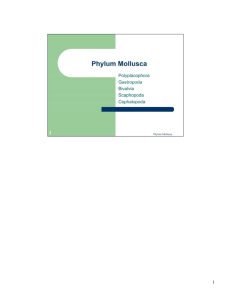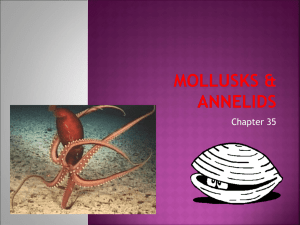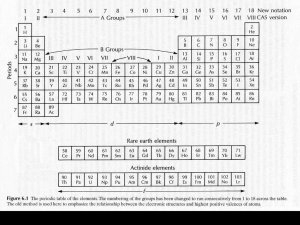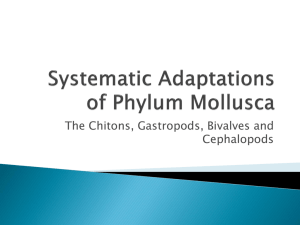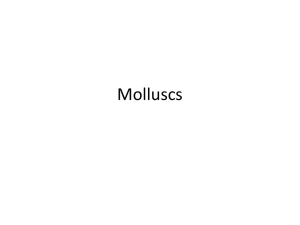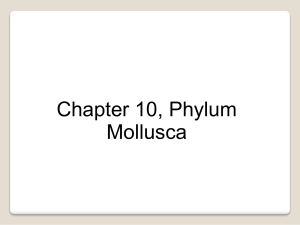Mollusca1
advertisement
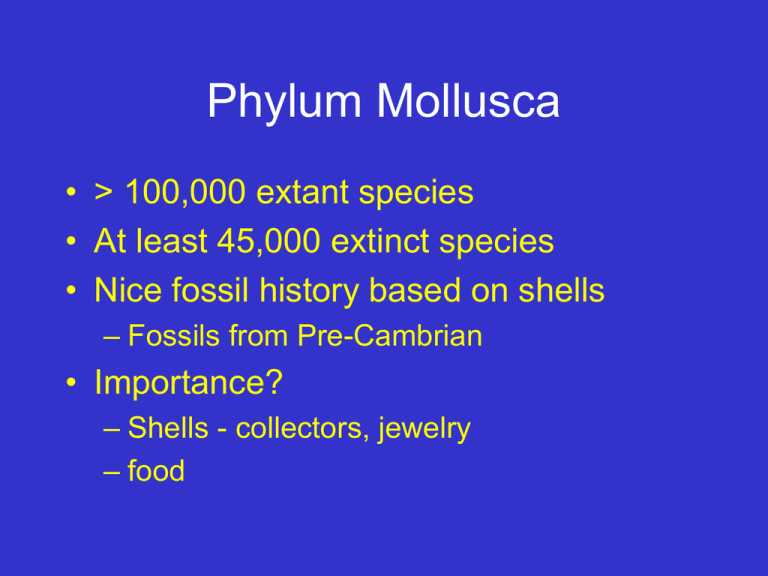
Phylum Mollusca • > 100,000 extant species • At least 45,000 extinct species • Nice fossil history based on shells – Fossils from Pre-Cambrian • Importance? – Shells - collectors, jewelry – food Mollusca characteristics: • 1. Foot • 2. Mantle • 3. Secretes shell Shell: 3 layers Periostracum: horny protein, conchiolin in some Prismatic layer: calcite crystals w/membranes between Nacreous layer: CaCo3 Mollusca characteristics: • • • • 1. Foot 2. Mantle 3. Secretes shell 4. External surfaces - ciliated epidermis w/ mucous glands – Food capture, feeding, locomotion, cleaning body surfaces Cilia move mucous and create water flow • Gas exchange + bring food in • Sorting surfaces separate food particles by size Cilia over gill surface • Water movement opposite of blood flow 5. Coelom is reduced • Only pericardial cavity 6. Open circulatory system • Blood sinuses (no capillaries) • Heart = one or two auricles – collecting chambers • one ventricle – pumping chamber More circ. system • Hemocyanin pigment in blood (copper) – Blood w/ O2 = blue – Blood w/o O2 = colorless • Pulmonate gastropods have hemoglobin • Cephalopods have closed circulatory system 7. Digestive system • • • • Sclerotized buccal cavity Tubular esophagus Cone-shaped stomach Long, coiled intestine Radula • Chitin-toothed • Rasping organ for scraping algae Stomach • Contains style sac, rotates contents – Pulls strands of mucous from esophagus – Mucous viscosity decreases w/ low pH – Stomach wall is chitinized • Crystalline rod = hyaline mucoprotein • Style has hydrolase digestive enzymes Stomach, cont. • Sort food particles by size • Intracellular digestion in digestive gland walls • Some extracellular dig. in stomach • Carnivores have no style Sorting in stomach Intestine • Fecal compaction • Anus opens into mantle cavity 8. Nitrogenous waste • Pair of coelomoducts – Open to pericardial cavity • Discharge into mantle cavity via nephridiopores – Probably not homologous to annelid metanephridia (annelid origin = mesoderm; mollusk origin = ectoderm) Waste product? • Ammonia in aquatic molluscs • Uric acid in terrestrial molluscs 9. Nervous system - varied • Polyplacophora (chitons) - decentralized, no ganglia • Cephalopods - as developed as in vert’s • Primitive gastropods: – Nerve ring around esophagus, 2 pair of major nerve cords Reproduction and development – Pair of gonads in coelom – Eggs + sperm into pericardial cavity, outside via coelomoducts – Fert external in sea water – Molluscs mostly dioecious, some gastropods hermaphroditic Most gastropods, all cephalopods: • Sperm transferred to female’s mantle cavity • Internal fertilization • Hermaphroditic gastropods do reciprocal cross-fertilization Development • Trochophore larvae = free-swimming eye stomach prototroch ciliated band mouth intestine protonephridium anus Trochophore larvae • • • • • Archaeogastropoda Polyplacophora Aplacophora Most marine bivalves Develops into veliger larvae – Foot, shell, other structures appear Phylogenetic significance of trochophore larvae • Hatschik (1878) • Present in molluscs, annelids, other phyla • Promotes ctenophora - trochophore theory of bilateral animals from radial ancestors – body shape, apical sense organs, statocysts, nervous systems Problem with ctenophoratrochophore connection • Flatworms don’t fit – Degenerate annelids? 7 mollusca classes • • • • • • • Polyplacophora Aplacophora Monoplacophora Gastropoda Scaphopoda Bivalvia Cephalopoda Class Polyplacophora • Chitons and oval-flattened beasts mostly in rocky intertidal zones • All marine, ~ 800 spp. • Mostly 2 - 12 cm • Largest (30 cm)is Cryptochiton stelleri from N. Pacific coast of N. America = Pacific gumshoe chiton Chiton characteristics: • Most feed on algae and microorganisms on rock surfaces • Few are predators on small inverts • 1. Rudimentary head – No tentacles or eyes Characters • 2. Mantle covers dorsal surface – Secretes 8-piece shell • 3. Broad, ventral foot • 4. Many paired gills in mantle cavity • 5. Anterior mouth with radula Repro: • 6. Dioecious – trochophore larvae, no veliger – external fert. in sea water mouth Gills in mantle cavity mantle foot Classification of Polyplacophora - 2 orders • Order Lepidopleurida: few genera, Hanleya NE coast • Order Chitonida - most chitons – Chaetopleura (New England - Fl) – Chiton (gulf coast) – Katherina (N. Pacific coast) – Cryptochiton (N. Pacific coast) – Mopalia – Ishnochiton Class Aplacophora • Solenogasters are worm-like molluscs 0.5 - 30 cm long – Largest is Epimenia verrucova; 30 cm • All marine • Mostly deep waters, 20 - 9000 m • Some crawl and feed on hydroids and corals • Poorly known, seldom seen, ~ 250 spp. Characteristics: • 1. Worm-like body shape • 2. No shell, mantle, or foot • 3. Cuticle w/layers of imbedded calcareous spicules • 4. Ventral surface has longitudinal pedal groove • 5. Hermaphroditic • 6. Radula well-developed Pedal groove cloaca Class Monoplacophora • Originally known only from fossils • Living Neopalina from 3600 m in Pacific Ocean coast of Costa Rica (1952) • Two genera – Neopalina (7 spp.) and Vema Characteristics: • 1. Dorsal surface covered by flat conical shell. • 2. Ventral surface with mantle, paired gills and foot. • 3. Multiple paired gills, coelomoducts, heart chambers, gonads, and retractor muscles. Neopalina: Dorsal Ventral Dissection: bivalve umbo anterior Remove valve
